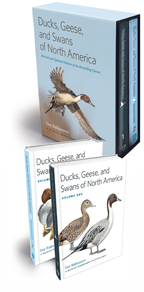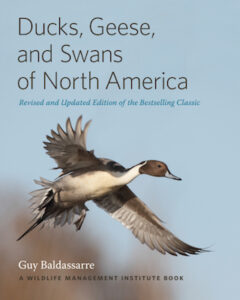One of the most valuable bits of advice – so it has been proven to me by experience – that I received back when I first took up bird watching was “always look at the ducks.” The logic was that ducks, being – like crows and gulls – so commonly seen by most people in the course of their daily lives, become practically invisible; they are passively seen but not actively noticed. Thus if one can train him or herself to always look for and pay attention to them, one can greatly improve one’s overall field craft in regard to all birds.
Fortunately, “looking at the ducks” was a bit of advice I readily took and continue to practice rigorously to this very day. As a result, I have been greatly rewarded with all I have been able to observe – not just about ducks but about all the other creatures who share their habitats, and indeed about those respective habitats as well. Of course, at some point, looking at the ducks made me curious to learn more about them; to give my observations context and meaning. Naturally, I sought out recommendations for a good source of information from more learned friends, and to-a-one they all recommended the same book: Ducks, Geese, and Swans of North America.
Since the initial publication of F.H. Kortwright’s Ducks, Geese, and Swans of North America by the American Wildlife Institute in 1942, ornithologists, bird watchers, waterfowl hunters, and general naturalists alike have turned to it – either in its original edition, or in Frank Bellrose’s revised second and third editions of it – as a (if not in fact “the”) definitive reference book on the subject. However just as the original edition eventually became dated in relation to new information discovered about its subjects in the years following its initial publication necessitated Dr. Bellrose’s revisions of it in the second and third, so in the mid 1990’s it was deemed necessary to begin work on a fourth. Dr. Bellrose himself took up the project and made significant progress until his health failed. When he died in 2005, in addition to all the other reasons all those who knew him had to mourn his passing was included the uncertainty of the fate of the fourth edition.
Fortunately for naturalists, waterfowl hunters, and all others interested in these species, in 2009, Guy Baldassarre, distinguished professor of wildlife ecology at the State University of New York’s College of Environmental Science and Forestry in Syracuse and the coauthor of the highly regarded Waterfowl Ecology and Management, agreed to take up the challenge of completing the fourth edition. Needless to note, it was a monumental undertaking; he was to be responsible for producing the newest edition of what had by this time become a canonical reference work for ornithologists and wildlife managers alike. The fact that as he progressed in this work, his own health began to fail, until in 2012 – having completed his work on the fourth edition and in the midst of reviewing the galleys for it – he died.
To look with a critical eye at the final work – the legacy opus – of a highly accomplished and well-respected scholar is not an easy task. What if it is not up to the standards of his previous works? What if it suffers from errors or incompleteness? What if it just isn’t that good? Would it be right – even decent – to point these things out with the man no longer able to defend the work himself?
 Thankfully in the case of Dr. Baldassarre’s Ducks, Geese, and Swans of North America
Thankfully in the case of Dr. Baldassarre’s Ducks, Geese, and Swans of North America, no such moral dilemmas come into play, for the work isn’t just good, it’s magnificent! Not only is it comprehensive in the information it contains about the biology, life histories, range, migratory patterns, and conservation and management issues pertaining to all of its forty-six included species, it is something that many other works of such magnitude are not: highly readable. Which means that not only professionals but amateurs as well can benefit from it.
Each included species is profiled in depth (and by in-depth, I mean in-depth; the section on the Mallard runs to fifty-two pages in length), with a standard arrangement of sections within each profile to make the location of information quick and easy. Beginning with identification, distribution, and migration behavior, each section then proceeds through habitat, population status, breeding biology, rearing of young, recruitment and survival, and concludes with food habits and feeding ecology, molts and plumages, and conservation and management. Indeed, there are few things one could want to know about the species included in the two volumes of this work that aren’t able to be found in its pages.
Then of course, there are the photos and illustrations. Original artwork by Robert. W. Hines – including such important depictions as wing patterning, and illustrations of the ducklings and goslings from each included species – is paired with some of the finest illustrative full-color photographs from noted wildlife photographers to be found anywhere. And if the maps printed with each species profile aren’t sufficient, a CD is also included that contains additional ones as well as citations for further reference if needed.
Quite frankly, it is difficult to imagine anyone, whatever their particular waterfowl-related activity or interest might be, who would not both enjoy as well as benefit from Ducks, Geese, and Swans of North America. Not only is it everything anyone familiar with the previous editions could have hoped for in a new edition, it is also a superb testament to the extraordinary intellect and writing skills of Dr. Baldassarre. As it will help tens, even hundreds, of thousands of people in the years to come better to understand the lives, habits, and ecological needs of North America’s waterfowl, a more fitting legacy to one who dedicated his life to studying and teaching about them can scarcely be imagined.
 Title: Ducks, Geese, and Swans of North America
Title: Ducks, Geese, and Swans of North America
Author: Guy Baldassarre
Publisher: Johns Hopkins University Press
Series: A Wildlife Management Institute Book
Format: Hardback
Pages: (two volumes) 1,088 pp., with 144 color photos, 138 color illus., and 50 maps
ISBN: 9781421407517
Publication Date: September 2014
—
Background information included in this review was drawn from both the publisher’s website as well as from the Wildlife Management Institute’s Outdoor News Bulletin.
By using this link to purchase Ducks, Geese, and Swans of North America through Amazon.com a portion of the purchase price will go toward helping The Well-read Naturalist continue to publish news and reviews of interesting and well-written books about natural history subjects.
In accordance with Federal Trade Commission 16 CFR Part 255, it is disclosed that the copy of the book read in order to produce this review was provided gratis to the reviewer by the publisher.

December 9, 2014 @ 16:28
Great review John
Review Roundup: December, 2014
January 8, 2015 @ 20:44
[…] The Well-read Naturalist […]